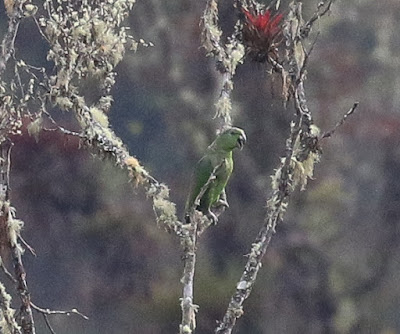This morning was another two hours before dawn start. We met the local guides who were going to be with us for the morning & we were quickly loaded into jeeps. No sooner than we left Santa Rosa we were on a very bumpy track. After a good hour & a half of bumping up & down on this very poor track, we were all thankful to come to a stop. I suspect it was primarily the poor quality of the jeeps, rather than the track, that made it an unpleasant ride. As it started to get light, we could see that we were on an open area of hillside, with trees within a few hundred metres away.
After about twenty minutes, the Fuertes's Parrot flew again & disappeared from sight. We didn't see any more. We did see another pair of the larger Scaly-naped Parrots & one perched up for some distant photos.
The Fuertes's Parrot site
Waiting in the light drizzle on another cold morning over 3000 metres: The Fuertes's Parrot landed in the trees at the back of the photo
The first Parrots to fly over were a pair of distant Scaly-naped Parrots. They kept flying & didn't linger. Then a different Parrot call was heard. Janos & the guides confirmed it was a Critically Endangered Fuertes's Parrot. The world population is restricted to the West slope of the Central Andes & thought to be only around 160 - 250 individuals. The species was only rediscovered in 2002 after a gap of 91 years of not being seen. I guess the combination of the major drug problems & the many years of civil war were the reasons for it being lost of science for so long. Fortunately, we picked the Fuertes's Parrot up in flight & saw it land somewhere in the trees. After a couple of minutes of searching, one of the group saw it perched up & we had reasonable scope views in the early morning light. The fields were private & walking along the road wouldn't have allowed a closer view. I wouldn't have been in favour of risking disturbing it, by trying to get much closer.After about twenty minutes, the Fuertes's Parrot flew again & disappeared from sight. We didn't see any more. We did see another pair of the larger Scaly-naped Parrots & one perched up for some distant photos.
Scaly-naped Parrot: This species occurs from Colombia & NW Venezuela to Ecuador, Peru & Bolivia
Having seen the main target species for the day, we walked further along the track away from the Santa Rosa.
The main track continued through patches of woodland & open rough grass fields
There was a reasonable selection of Hummingbirds, including two Tourmaline Sunangels, two Mountain Avocetbills, three Purple-backed Thornbills, four Tyrian Metaltails and singles of Buff-winged Starfrontlet, Mountain Velvetbreast & Sword-billed Hummingbird.
Purple-backed Thornbill: Juv. The adults have a deep purple back wings, crown & nape. The juveniles are more subtle
Buff-winged Starfrontlet: This is a larger Hummingbird with a noticeably longer bill & a pale buff panel
Buff-winged Starfrontlet: They occur from the Central Colombian Andes through Ecuador to extreme NW Peru
Black-capped Tyrannulet: Another species which occurs from Colombia & Venezuela South to Ecuador & Peru
Cinnamon Flycatcher: This is a widespread species which occurs from Colombia to Peru & NW Argentina
Cinnamon Flycatcher: This is a widespread species which occurs from Colombia to Peru & NW Argentina
Rufous-breasted Chat-tyrant: This looks more like a Flycatcher you could see in China or SE Asia than a Neotropical Tyrant-flycatcher
We quickly started to run into small parties of Mountain-tanagers. First up was a small party of Hooded Mountain-tanagers, followed by Lacrimose Mountain-tanagers & Scarlet-bellied Mountain-tanagers.
Hooded Mountain-tanager: The black head without any yellow and blue band across the belly separates Hooded Mountain-tanagers from the other similar-looking species
Hooded Mountain-tanager: This species occurs from Colombia & West Venezuela and South to Ecuador, Peru & Bolivia
We stopped again a bit closer to Santa Rosa for another stretch of roadside track Birding, which was productive.
Grey-breasted Mountain Toucan: Another species of the Central Andes of Colombia, Ecuador & Peru. This individual was very dexterous in being able to select & eat single berries
Great Thrush
We arrived back at the hotel as had chance to look at a few garden species, whilst packing the minibus & having a quick cup of coffee.
Blue-and-white Swallow: A fairly common species which occurs from Costa Rica as far South as Chile and Argentina
We only drove for a few minutes from the hotel before pulling into a restaurant for lunch.



















